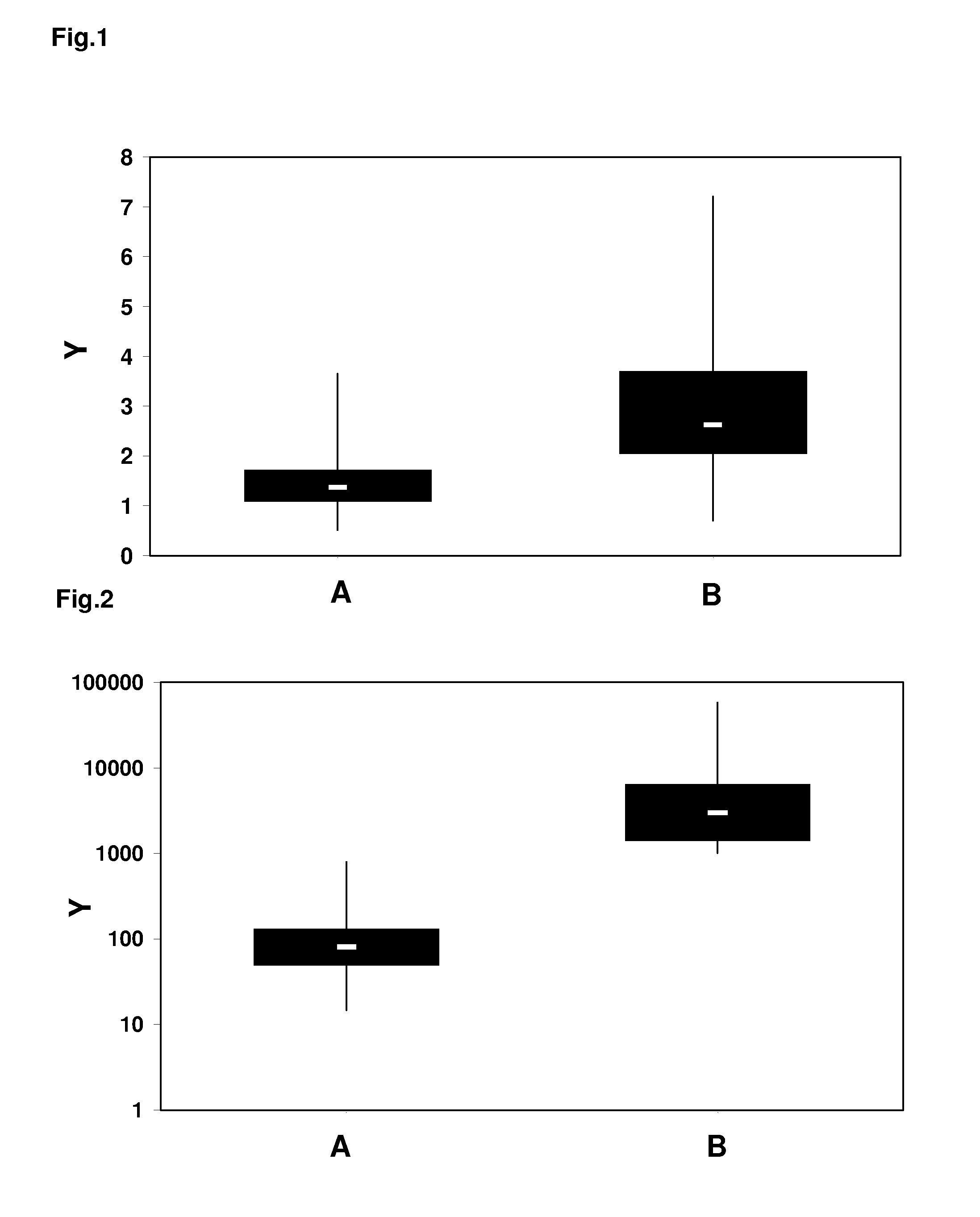Timp-4 as a biomarker for the diagnosis of cardiac insufficiency
- Summary
- Abstract
- Description
- Claims
- Application Information
AI Technical Summary
Benefits of technology
Problems solved by technology
Method used
Image
Examples
example 1
[0108]Owing to the high volume load on the heart, patients with heart failure are characterized by increased NT-proBNP plasma concentrations (see above). If the NT-proBNP concentration exceeds a value of 900 pg / mL, regardless of the patient's age and sex there is heart failure with 87% probability (see above). At NT-proBNP levels <300 pg / mL heart failure is ruled out with very high probability. Based on these relations, the TIMP-4 concentration was determined in serum samples from two groups of patients: 1) donors whose NT-proBNP level was between 15 and 795 pg / mL (median=81 pg / mL (no heart failure)). 2) donors whose NT-proBNP level was between 1016 and 58171 pg / mL (median=2976 pg / mL (high probability of heart failure)) (FIG. 2). The TIMP-4 serum concentration of the high-NT-proBNP group was increased highly significantly compared with the low-NT-proBNP group (FIG. 1) (low-NT-proBNP: median: 1.37 ng / mL, 25-75% percentile: 1.09-1.73 ng / mL, min.: 0.51 ng / mL, max.: 3.66 ng / mL; high-NT-...
example 2
[0109]Patients with terminal heart failure (NYHA IV), whose clinical situation has not improved under pharmacotherapy to the extent that intensive medical care has become unnecessary, and for whom in the short term no donor heart is available, are dependent on the implantation of a ventricular assist device (VAD) (see above).
[0110]The TIMP-4 concentration in serum samples from patients who were on the list for implantation of a left ventricular assist device (LVAD) was compared with the TIMP-4 concentration in serum samples from healthy blood donors (FIG. 3). The TIMP-4 serum concentration in pre-LVAD patients was increased highly significantly compared with the healthy control group (control: median: 1.20 ng / mL, 25-75% percentile: 0.96-1.54 ng / mL, min.: 0.62 ng / mL, max.: 3.69 ng / mL; pre-LVAD: median: 2.52 ng / mL, 25-75% percentile: 1.70-3.45 ng / mL, min.: 0.40 ng / mL, max.: 6.07 ng / mL; p<0.001).
example 3
[0111]An important cause of right heart hypertrophy (cor pulmonale) and the resultant right ventricular failure is pulmonary hypertension, which is characterized by an increase in the resting pulmonary artery pressure (PAP) to values >25 mmHg (see above).
[0112]The TIMP-4 serum concentration of patients with right heart failure and pulmonary hypertension (RHI / PH) (n=25) was compared with the TIMP-4 serum concentration of healthy test subjects (n=25) (FIG. 4). The TIMP-4 serum concentration in the RHF / PH patients was increased highly significantly compared with the healthy control group (control: median: 1.14 ng / mL, 25-75% percentile: 0.90-1.28 ng / mL, min.: 0.59 ng / mL, max.: 1.43 ng / mL; RHF / PH: median: 2.30 ng / mL, 25-75% percentile: 1.90-2.90 ng / mL, min.: 1.0 ng / mL, max.: 5.60 ng / mL; p<0.001).
[0113]Materials and Methods
[0114]Sample Material
[0115]The TIMP-4 concentration in human serum samples was determined in two different studies.[0116]1) The TIMP-4 concentration in serum samples fr...
PUM
 Login to View More
Login to View More Abstract
Description
Claims
Application Information
 Login to View More
Login to View More - R&D
- Intellectual Property
- Life Sciences
- Materials
- Tech Scout
- Unparalleled Data Quality
- Higher Quality Content
- 60% Fewer Hallucinations
Browse by: Latest US Patents, China's latest patents, Technical Efficacy Thesaurus, Application Domain, Technology Topic, Popular Technical Reports.
© 2025 PatSnap. All rights reserved.Legal|Privacy policy|Modern Slavery Act Transparency Statement|Sitemap|About US| Contact US: help@patsnap.com



